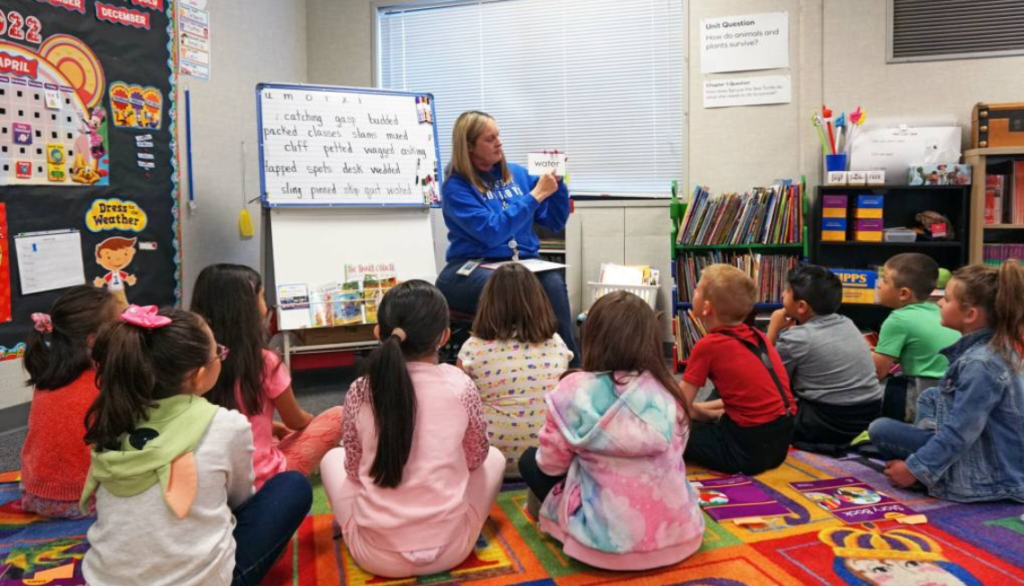Despite a national focus on the science of reading, states, including California, are not doing enough to support and train teachers to effectively teach literacy, according to a report released Tuesday by the National Council on Teacher Quality (NCQ).
Over the past decade, 32 states have passed laws or implemented policies related to evidence-based reading instruction. Nonetheless, nearly every state could do more to support literacy instruction, according to the report, titled Five Policy Actions to Strengthen Implementation of Reading Science.
Commission Chair Heather Peske told EdSource, “While states are rightly prioritizing literacy, they are not paying enough attention to teacher effectiveness and the ability of teachers to teach reading aligned with science.” “If these efforts are to be successful …… state governments need to ensure that teachers are prepared and supported from the time they enroll in teacher training programs to the time they enter the classroom.”
The report categorizes states as strong, moderate, weak, and unacceptable based on whether they have policies in place to ensure that students receive science-based reading instruction that includes teaching them to read words, a process known as natural spelling. Only 12 states – Arkansas, Colorado, Florida, Louisiana, Minnesota, Mississippi, Ohio, Rhode Island, Tennessee, Texas, Utah and Virginia – were rated as strong.
California received a moderate rating.
The state received high marks for setting reading standards for teacher-training programs, implementing a rigorous reading licensure exam for teachers, and requiring districts to select high-quality reading courses. California scored low on whether it requires ongoing literacy training for teachers and whether it monitors teacher preparation programs to ensure they teach reading science.

Not all teachers trained in reading science
While California provides funding for school districts to provide literacy training for teachers, it does not require all elementary school teachers to be trained in reading science as other states do, Peske said. Without proper training, he added, teachers often struggle to teach literacy, even though they have access to high-quality instructional materials.
Effective instruction is critical to improving students’ reading skills. More than 90 percent of students will learn to read with effective reading instruction, according to the report.
According to the study, about 40 percent of U.S. fourth graders can read at a basic level. The latest California test scores show that fewer than half of the students who took the test were proficient readers. Those results haven’t changed much in the past decade.
“Why do we see an alarming number of children, especially children of color and from low-income families, without basic literacy skills?” Dennis Ford, president and CEO of The Education Trust, said. “That’s because in many districts and schools across the country, outdated teaching methods and curricula are still being used that have been shown to be ineffective and even harmful.”
Peske said the report comes at a time when California and other states are refocusing on the science of reading, which is based on more than 50 years of research that provides a clear picture of how effective literacy instruction can produce skilled readers.
According to the report, only two of the 41 teacher preparation programs reviewed in California adequately cover all five components of the science of reading. These five components include phonics, phonemic awareness, fluency, vocabulary, and comprehension.

California’s renewed focus on reading
But that may soon change. By July 1, California will require teacher preparation programs to provide literacy training based on the science of reading and the state’s new literacy standards. The new standards include supports for struggling readers, English language learners, and students with special needs, and for the first time incorporate dyslexia guidelines (PDF).
The state will also eliminate the unpopular Reading Instructional Proficiency Assessment in 2025. It will be replaced with performance assessments based on literacy standards and a new set of instructional performance expectations.
Mary Vesey Sandy, executive director of the California Commission on Teacher Credentialing, said, “This updated set of standards and tpe may be the strongest statement we have ever made about reading and literacy in teacher preparation.” “We will leave no stone unturned to put them into practice.”
More than half of the states use outside accreditors to review teacher preparation programs, which researchers say is not ideal. The report lists California as one of those states, but Sandy said that’s not the case.Sandy said California’s teacher-training programs must be reviewed every seven years by a commission-approved Institutional Review Board, which is made up of university faculty members and practitioners in all certification areas. She said members are trained in the standards or have a background or certification in the subject matter being reviewed.
Sandy said teacher preparation programs that want to be nationally accredited have the option of using an outside accrediting agency, but are not required to do so for state accreditation.
California should also incorporate data collected on teachers’ pass rates on the state reading licensure exam into the review of teacher-training programs, Peske said.
In evaluating California, researchers from the National Council on Teacher Quality considered changes in California’s emphasis on teacher preparation and on the science of reading, Peske said. The study was also sent to the California Department of Education for review at least twice. No one at the department has said the study is wrong, according to the commission.
The commission provides a guide to help states implement and sustain strong reading instruction.
Peske said, “If your teachers are prepared in the science of reading, it is possible to help all children learn to read.” “Just as an orchestra needs individual instruments to come together to create successful music, states need to implement multiple teacher-centered reading policies that work together to improve student achievement.”
